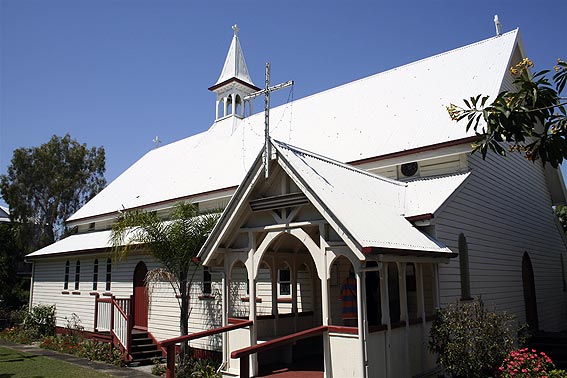
St John's Anglican Church, Bulimba
[Photograph by Trevor Bunning (October 2007)]

St John's Anglican Church, Bulimba
[Photograph by Trevor Bunning (October 2007)]
Historical and Technical Documentation by Geoffrey Cox1
© OHTA 1989, 2007, 2014, 2015 (last updated July 2015)
European settlement of Bulimba began in the early 1850s with farming of small crops and fishing along the river. Anglican residents in the area belonged originally to St Andrew's Parish, South Brisbane, but the Bulimba Mission was established in the late 1880s. Before St John's Church was built, services were conducted in the local School of Arts.2
The historic timber church of St John the Baptist was opened on St Matthew's Day, 21 September 1888, having been designed by the Brisbane diocesan architect, J.H. Buckeridge.3 The interior paneling, fitted in the 1930s, comes from the captain's cabin of the 'Maheno', a luxury passenger steam ship wrecked on Fraser Island off the Queensland coast in 1935, and the church's bell also came from the 'Maheno'.4
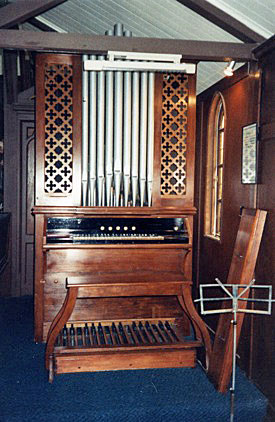
The organ at St John's Anglican Church, Bulimba
[Photograph by Howard Baker, 1989)]
Beyond the fact that the organ at St John's had come from St Andrew's Anglican Church, Lutwyche, the builder and date of the instrument remained obscure for many years. At Lutwyche, the instrument was originally in the old church, where it occupied a similar position to the one it now occupies at Bulimba, but on the opposite side of the church.

Interior of the old St Andrew's Anglican Church, Lutwyche,
showing the organ now at St John's Anglican Church, Bulimba
with stenciled façade pipes
[Photograph from K.H. Addison et al,
The Growth of Lutwyche Parish (1951), p. 20]
The organ remained in the old Lutwyche church until it was moved to the new church, which was opened in August 1926.5 There is record of a single payment of £9 to Whitehouse Bros of Brisbane in August 1926 and records of tuning by Whitehouse Bros from this time onwards.6 As a new organ was being built for the Lutwyche parish, negotiations to sell the old instrument took place throughout 1929,7 and it was eventually sold to St John's Church, Bulimba, in September that year:
. . . Mr Poole reported regarding his efforts to dispose of the old instrument culminating in the fact that Revd Steer of the Bulimba Parish has purchased the old organ through Whitehouse Bros ….8
The records of St Andrew's, Lutwyche, give little information about the origins of the organ. The first reference to a pipe organ at St Andrew's seems to be in 1915, when some concern was expressed over the condition of the instrument:
Mr Charity commented on the condition of the Pipe Organ at St Andrew's & moved that the council at its next meeting be recommended to arrange for the purchase of a small organ for emergency use.9
Six months later, the problems had apparently been rectified.10 Given the reported condition of the organ, it appears that the instrument was second-hand. There is record of a single payment of £12 to Whitehouse Bros in December 1923 for work of an unspecified nature.11
Although its original location is not recorded, there is strong evidence to suggest that the organ came from All Saints' Anglican Church, Yandilla. Details concerning the organ at Yandilla have emerged following the publication in 1987 of Grant Uebergang's booklet commemorating the centenary of the dedication of All Saints' Church, and Mr Uebergang has greatly assisted in supplying other source material that is acknowledged in the footnotes following.12
In conjecturing a connection between the organs at Yandilla and Lutwyche, it is significant that the Rector of St Andrew's at the time was Canon E.C. Osborn, whose eldest son, The Revd Norman Osborn, was Rector of Pittsworth.13 The Yandilla church was under the auspices of the Pittsworth parish at this time, and by 1912 the organ at Yandilla was described in the Annual Report of the Pittsworth parish as being in poor condition. There was reference to:
… the expense of replacing the organ, which is, we are sorry to say, quite worn out. It was decided at a meeting of the congregation to take advantage of an offer from Paling's for the purchase of the old organ and to purchase a good instrument in its place.14
By mid 1913, it was reported that 'during the past year the old pipe organ has been disposed of, and a smaller but more suitable instrument has been installed.'15
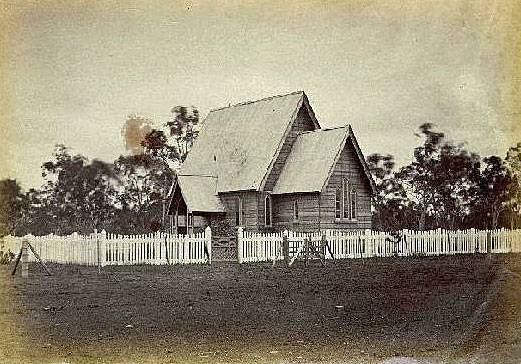
The 1878 Church at Yandilla
[Photograph from the Hume Family Collection,
Fryer Library, University of Queensland]
Later sources (dating from the 1950s) mention that the organ was sold by The Revd Norman Osborn, then rector of Pittsworth, to a second-hand dealer in Brisbane opposite the Taxation Office, from whom a new organ was purchased at the same time.16 This was presumably W.H. Paling & Co., and the replacement was probably a harmonium.
Quite apart from the connection between Canon E.C. Osborn of Lutwyche and his son Revd Norman Osborn of Pittsworth, the coincidence of dates between the two locations is compelling. The organ removed by mid-1913 from Yandilla is quite plausibly the one that appeared around 1915 or earlier at Lutwych.
The removal of the organ from Yandilla was still the cause of some regret as late as 1940, when it was reported to be located in a parish church (not named) in Brisbane:
Regret has been expressed that the pipe organ was removed from the Yandilla church and was now in a parish church in Brisbane. Archdeacon Glover is hopeful that the organ will be restored to what he states is its rightful place – the church at Yandilla.17
All Saints' Church, Yandilla
[Photograph by Geoffrey Cox (June 2012)]
The organ at All Saint's, Yandilla, had been built by The Revd William Francis Gore (1819-1885), who was associated intermittently with Yandilla between 1859 and 1878. All Saints' is a timber church erected at Yandilla Station by the Gore family around 1878, replacing an earlier building dating from 1863.18 It was dedicated as 'All Saints' Church of England' in 1887.19 W.F. Gore bought into the family business there in 1860, and his eldest son, Francis Arthur Gore, managed the property from 1866 until his death in 1904.20
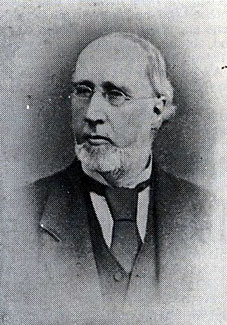
The Revd William Francis Gore (1819-1885)
[reproduced in G. Uebergang, A History of All Saints
Anglican Church, Yandilla, Queensland (1987)]
W.F. Gore had been Rector of All Saints' Church, Parramatta, NSW, 1849-62.21 He returned to England with his family in 1862,22 but appears to have visited Yandilla intermittently after that. He opened the first church there in 1863, was actively involved in opposition to the Homestead Areas Bill of 1872,23 and he celebrated baptisms at Yandilla in 1872 and 1877-78.24 Further biographical details of W.F. Gore, supplied by Ms Prue Gore of Somerset, Tasmania, reveal that he was resident in England from 1863 until his death in 1885:
The Revd W.F. Gore, son of the Revd Thomas Gore (1766-1834) was born in Wexford, Ireland, on 9 November 1819. He arrived in Australia with his mother and immediate family at the age of 22 on 5 November 1841, and was ordained to the Anglican priesthood in Australia in December 1844 by Bishop W.G. Broughton. He served as Incumbent first at St Alban's Church, Musswellbrook, and then at All Saints', Parramatta, 1849-1862. He sailed for England in April 1862, although he did not formally resign the incumbency at Parramatta until 1867.
Gore was resident in 1863 at Wimbledon, Surrey; by 1867 at Hawkhurst, Kent; and by 1871 at Kenton, East Devon. He is recorded as being resident at 'Feniton Court', Devon, from at least 1875 until at least 1881. By 1883 he had moved to 'The Old House', Betchworth, Surrey. He died on 2 April 1885, and is buried in St Michael's churchyard, Betchworth, Surrey, where his headstone still stands.25
Gore's involvement with pipe organs is recorded on more than one occasion. It was while he was living at Feniton Court in Devon that work was undertaken in 1877 on the organ in the nearby St Andrew's Parish Church. The organ appears to have been moved at this time from the west gallery to the north nave, and it was enlarged at some stage from one to two manuals.26 It became known as 'Rev. Gore's organ', suggesting that he was in some way involved. Gore was also known at Feniton to have made an organ for a church in Australia.27 The organ at Feniton Parish Church was damaged by flooding in 2008, and removed in 2010.28
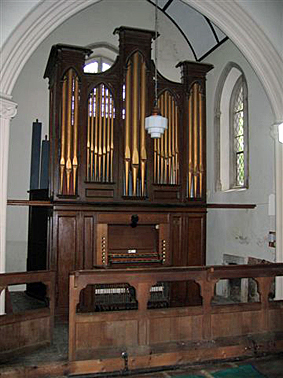
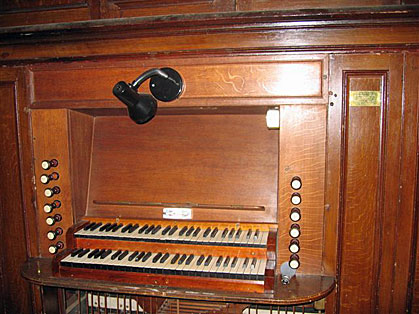
The organ at St Andrew's Parish Church, Feniton, Devon
[Photographs by David Lanning, Churchwarden (2010)]
Gore is commemorated at Yandilla by the stained glass windows, sent out from England by his sister after his death, and installed above the altar in the Yandilla church around the time it was consecrated as All Saints' in 1887.29 It is likely that the organ was similarly sent out from England. It was installed in All Saints' Church after Gore's death, and there is no evidence that it was ever located in the Gore homestead at Yandilla, as has been suggested.30
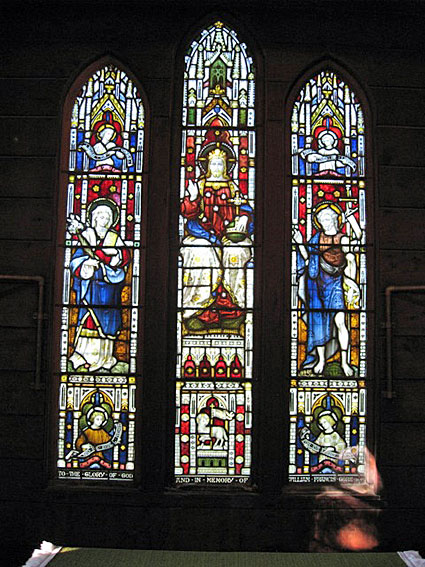
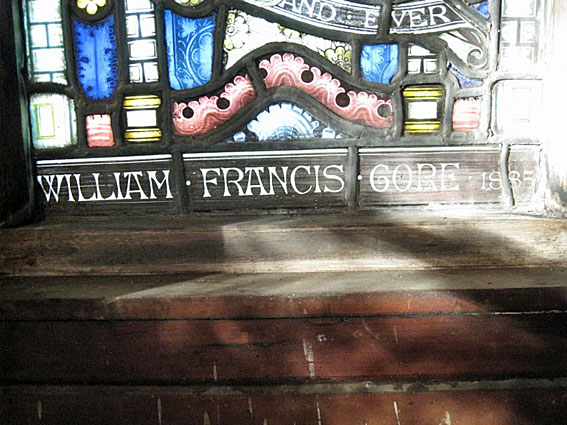
The stained-glass window at Yandilla,
installed around 1887 to commemorate W.F. Gore's death in 1885
[Photographs by Geoffrey Cox (June 2012)]
The date of the organ's installation at All Saints' Church is not clear. Grant Uebergang gives 1888,31 although there is no sign of the organ in a photograph of the church interior dating from that year. It is most likely, however, that the organ was placed in one of the corners at the back of the church, as there is no suitable space at the front.
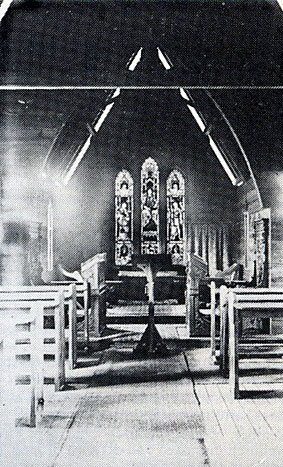
The interior of All Saints' Church, Yandilla, 1888
[Photograph by Joan Whitaker, Glen Innes, NSW,
reproduced in G. Uebergang, A History of All Saints
Anglican Church, Yandilla, Queensland (1987)]
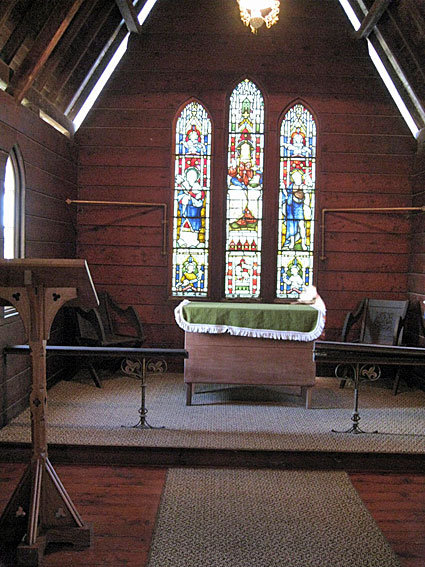
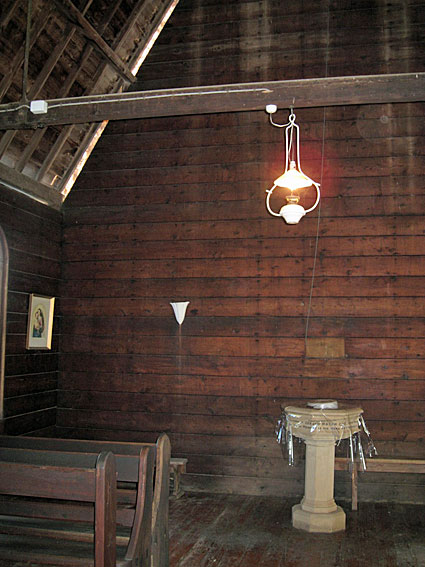
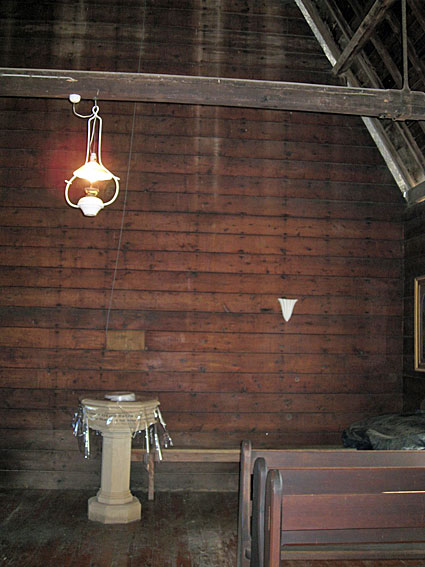
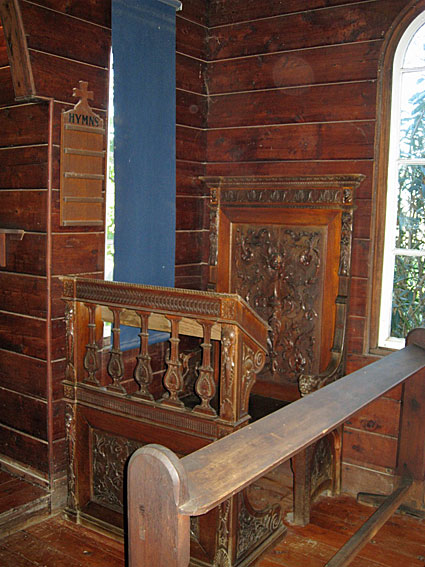
Interior aspects of All Saints' Church,
including space at the back of the church where the organ may have been located
[Photographs by Geoffrey Cox (June 2012)]
In the Yandilla Parish Report for April 1890 to March 1891, it is stated that 'Mrs F.A. Gore continues to play the harmonium,'32 and the Easter Report for 1892 refers to a 'new harmonium':
Yandilla. There is a marked improvement in the service held in this church. Regular choir practice under the able management of Mrs F. A. Gore have resulted in a much heartier service than of yore. Outside people still seem shy of coming into the Mother Church except on very special occasions. A new harmonium has been placed in the church …33
The year 1892 is elsewhere given as the date when W.F. Gore's pipe organ was installed in the Yandilla church,34 and it is possible that the 'new harmonium' reported that year was in fact Gore's pipe organ.
It is not clear whether the organ was present when All Saints' Church was slightly flooded in 1890, but it is reported in any case that no permanent damage was sustained.35 Gore's eldest daughter, Katherine, visited Yandilla in 1910, and referred to the organ as follows:
There is a dear little church on Yandilla … the very nice organ in it was made by my father, who was both a good carpenter and a good musician.36
At the time of installation by Whitehouse Bros at Bulimba in 1929, work on the organ included 'repairing & erecting' as well as 'polishing case work' and 'decorating front pipes.'37 The organ was moved at Bulimba from the north to the south side of the building in the early 1950s, when the rood screen was relocated from the chancel to the rear of the nave. An electric blower was installed at this time.38
The instrument was returned to playing order in 1979 by H.W. Jarrott of Brisbane, who observed that the pipework had never been enclosed in a swell box, and that the case was originally of closed timber panels which allowed little egress of the sound. These panels were partly replaced by fretwork in 1979. Jarrott's impression was that the instrument appeared to date from the early nineteenth century, although he observed that the Bourdon 16ft stop was a later addition, probably c.1923.39 The knob for this stop is located to the far right on the console, separated from the other stop knobs. This may possibly have been the unspecified work carried out by Whitehouse Bros in December 1923 at a cost of £12, to which reference has already been made.
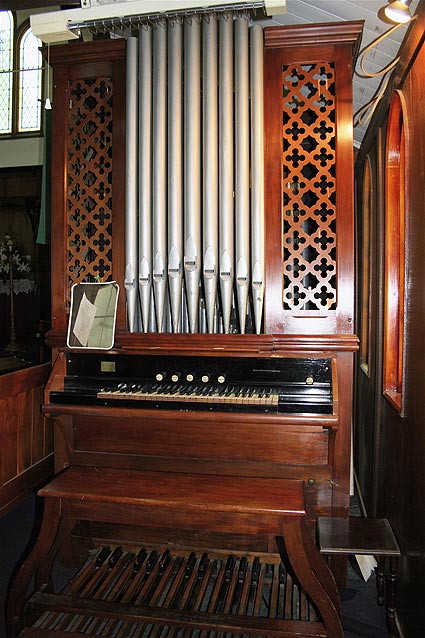
W.F. Gore's organ at St John's Anglican Church, Bulimba,
showing the fretwork panels added in 1979
[Photograph by Trevor Bunning (October 2007)]
In 2014, the organ was restored by W.J. Simon Pierce of Brisbane, with the addition of two new stops (Stopped Flute 4ft and Fifteenth 2ft) on the manual. The Bourdon 16ft was completed to 29 notes, with a new soundboard and mechanical action, now playable only on the Pedals, which are permanently coupled to the manual. Jarrott's fretwork (plywood) panels were replaced with cloth, and the façade pipes were repainted and decorated. The organ was dedicated on 2 November 2014.40
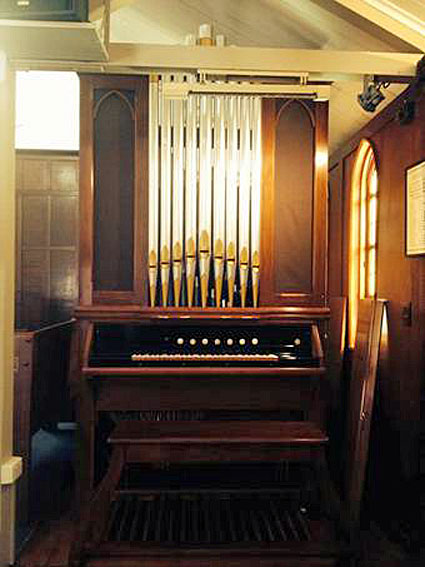
The restored and enlarged organ at St John's Anglican Church, Bulimba
[Photograph by Simon Pierce (October 2014)]
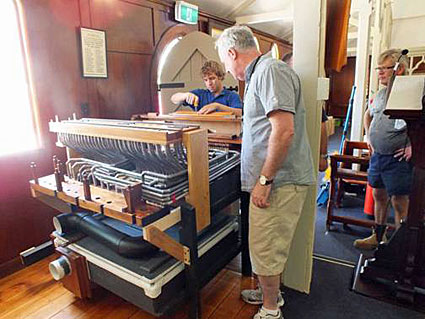
View of the organ being installed,
showing the elevated windchest for the additional two stops
[Photograph by Simon Pierce (October 2014)]
The conjecture that the organ was made in England is confirmed by the fact that none of the timber in the organ is Australian. The instrument appears to incorporate parts from an older instrument. The original pipework was discovered in 2014 to be a mixture of pipes from an earlier larger organ, with some pipes of the Diapason and Principal ranks marked as 15th, although definitely of the same origin.41 The soundboard is placed unusually low in relation to the case, which retains the nine original non-speaking façade pipes, no longer stenciled. The square oak shanks on the draw-stops and the compass suggest that parts of the instrument, at least, date from before 1860. It was originally hand-blown.42
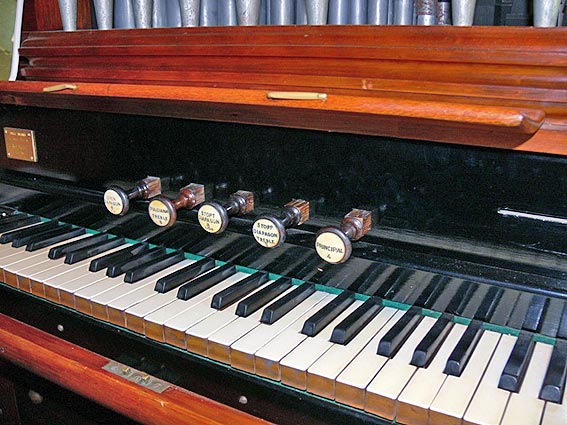
Console details, including the square oak shanks on the draw-stops
[Photograph by John Maidment (October 2007)]
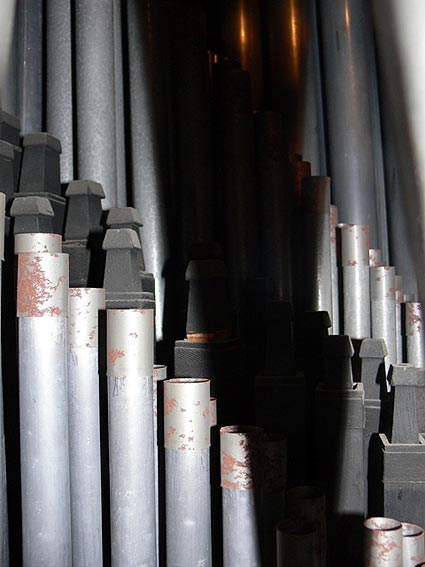
Pipework of W.F. Gore's organ at St John's, Bulimba,
showing spotted-metal pipes of the Open Diapason 8ft at the rear,
pierced stoppers of the Stopt Diapason 8ft,
and unspotted-metal pipes of the Principal 4ft at the front
[Photograph by John Maidment (October 2007)]
Given that Gore was resident at Feniton, c.1875 - c.1881, and given his association with the organ in St Andrew's Parish Church there, it is possible that the organ for Yandilla was constructed by Gore using parts of an earlier organ, possibly even the earlier one-manual organ at St Andrew's. The association of the Yandilla organ with Feniton is supported also by the presence originally of four oak boards mounted above the organ, with the following inscription in old English characters:
Gore made me, Gore played me;
And if my breath o'er live your death
Ye shall live on when I am gone,
If while you play you work and pray.43
The four oak boards were reported to have come from an oak tree in the grounds of the Gore family home, Feniton Court in Devon.44 The matter is slightly confused by Grant Uebergang's statement that the oak boards 'from which the organ was made' came from the Gore family home.45 The earlier sources state only that the four boards above the organ were of oak.
The specification is as follows:
| MANUAL | ||
| Open Diapason Dulciana Treble Stopt Diapason Bass Stop'd Diapason Treble Principal Stopped Flute Fifteenth |
8 8 8 8 4 4 2 |
[Tenor C] [Tenor C] [bottom octave] [Tenor C] [2014] [2014] |
PEDAL [permanently coupled to Manual] |
||
| Bourdon |
16* |
[originally 12 notes only, bottom octave] |
Compass: 54/29
Pedalboard: flat and straight
Mechanical action.
* originally on the Manual, and labelled 'Bourdon 16Ft Tone', this stop was a later addition.46
___________________________________________________________________________
1 Earlier versions of the historical documentation presented here appeared in the OHTA Conference books for 1989 and 2007, and in: Geoffrey Cox, 'Two Early Colonial Organs in Queensland: The Gore Family of Yandilla,' OHTA News, vol. 32, no. 3 (July 2008), pp. 14-22.
2 Queensland Heritage Council, Queensland Heritage Register, location 601174.
3 Glenda Murrell, Anglican Records and Archive Centre Guide to Records (DioceseofBrisbaneWeb, 2001) - cited January 2004.
4 Celebrating the Dedication Centenary of St John the Baptist, Bulimba, 1889-1989, supplied by Fr Mel Knowles, 1989.
5 K.H. Addison et al, The Growth of Lutwyche Parish (Lutwyche: St Andrew's Parish, 1951), pp. 23-24.
6 Whitehouse Bros Ledger (1922-1940), pp. 184, 197.
7 Minutes of the Parochial Council meetings of St Andrew's, Lutwyche, 8 January 1929 & 9 May 1929, and Easter meeting 17 April 1929 (cited at Anglican Diocese of Brisbane Records & Archive Centre).
8 Minutes of the Parochial Council meeting of St Andrew's, Lutwyche, 10 September 1929 (cited at Anglican Diocese of Brisbane Records & Archive Centre).
9 Minutes of the Adjourned Annual General meeting of St Andrew's, Lutwyche, 17 May 1915 (cited at Anglican Diocese of Brisbane Records & Archive Centre).
10 Minutes of the Parochial Council meeting of St Andrew's, Lutwyche, 7 October 1915 (cited at Anglican Diocese of Brisbane Records & Archive Centre).
11 Whitehouse Bros Ledger (1922-1940), p. 119.
12 Grant Uebergang, A History of All Saints Anglican Church, Yandilla, Queensland . . . commemorative booklet for the 100th anniversary of the dedication of All Saints 1887-1987 (Pittsworth: The Pittsworth Sentinal, 1987).
13 Personal communication to G. Cox from Ken Addison, August 2007.
14 Supplement to S. Andrew's Pittsworth, Parish Magazine (June 1912), p. 11, supplied by Grant Uebergang.
15 Supplement to S. Andrew's Pittsworth, Parish Magazine (June 1913), p. 14. [The date of the sale of the organ is given as 1914 in both Uebergang, p. 46, and in the Queensland Heritage Council, Queensland Heritage Register, location 600722].
16 Hazel Fysh, Notes on All Saints' Church, Yandilla [Manuscript, 1958]; 'Some Facts about the Gore Families of Yandilla' [Typescript notes, 1960], formerly in the Darling Downs Local History Collection, Darling Downs Institute of Advanced Education. These typescript notes incorporate the full text of a brochure 'The Yandilla Estate 1841-1910' published by Gerard R. Gore around 1910. Both of these sources supplied by Grant Uebergang.
17 Toowoomba Chronicle (4 November 1940), p. 6, supplied by Grant Uebergang.
18 Queensland Heritage Council, Queensland Heritage Register, location 600722; Uebergang, pp. 15-19.
19 Uebergang, p. 28.
20 Uebergang, pp. 13-16, 22, 61.
21 List of incumbents at All Saints', Parramatta, cited at Parramatta by G. Cox, January 2006. Gore is described incorrectly as Rector of St John's, Parramatta, in Graeme Rushworth, Historic Organs of New South Wales: The Instruments, Their Makers and Players 1791-1940 (Sydney: Hale & Iremonger, 1988), p. 226.
22 'Some Facts about the Gore Families of Yandilla' [1960], p. 4.
23 Uebergang, pp. 15-17.
24 'Some Facts about the Gore Families of Yandilla' [1960], p. 4; Uebergang, p. 22.
25 Prue Gore in personal communication to Grant Uebergang (March & April 2008), reported in Cox, op. cit., p. 21.
26 British Institute of Organ Studies, The National Pipe Organ Register - http://www.npor.org.uk - accessed January 2012.
27 Prue Gore, op. cit.
28 Personal communication to G. Cox from David Lanning, Churchwarden of St Andrew's Parish Church, Feniton, 13 January 2012. The organ was damaged when the church was severely flooded in October 2008. It was removed in August 2010, having been sold to the Dutch company, Feenstra Orgelrestauratie, Grootegast, who specialise in organ restoration and intend to sell it on.
29 Uebergang, pp. 25, 28-29, 57-60.
30 John Chappell in The Sydney Organ Journal, vol. 34, no. 1 (Summer 2002-03), p. 8.
31 Uebergang, p. 26.
32 Hazel Fysh, p. 1; Uebergang, p. 30.
33 Hazel Fysh, pp. 2-3.
34 'Some Facts about the Gore Families of Yandilla' [1960], p. 5.
35 Uebergang, p. 30.
36 Uebergang, p. 42.
37 Whitehouse Bros Ledger (1922-1940), p. 488.
38 Queensland Heritage Council, Queensland Heritage Register, location 600722.
39 Personal communication to G. Cox by H.W. Jarrott, 1987-88, recorded in Organ Society of Queensland Newsletter, vol. 16, no. 1 (August 1988), pp. 9-11.
40 'Off the Chest: News from the Organ Builders,' The Sydney Organ Journal, vol. 46, no. 1 (Summer 2014-2015), p. 35; Personal communication to G. Cox from Simon Pierce, December 2014; Simon Pierce, "New Work in Queensland and New Zealand,' Organ Australia (Winter 2015), pp. 40-41.
41 'Off the Chest: News from the Organ Builders' op. cit.
42 Observations by John Maidment, 1989.
43 Uebergang, pp. 25-26; An alternative version of the wording is given by Hazel Fych, op. cit: 'Gore made me / Gore played me / While I have breath & until his death / May Gore play on'.
44 Hazel Fysh, appendix pp. 2-3; 'Some Facts about the Gore Families of Yandilla' [1960], p. 6.
45 Uebergang, p. 25.
46 Specification noted by G. Cox, 1973, 1989 and 2007, with added details from 'Off the Chest: News from the Organ Builders,' op. cit.